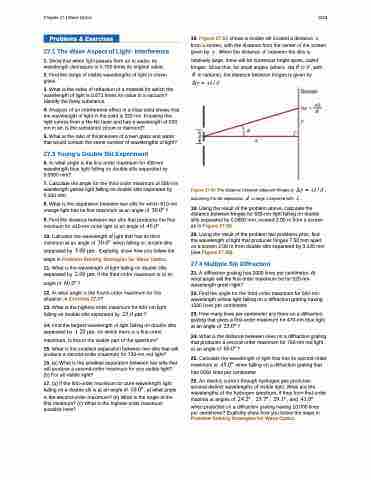Page 1255 - College Physics For AP Courses
P. 1255
Chapter 27 | Wave Optics
1243
Problems & Exercises
27.1 The Wave Aspect of Light: Interference
1. Show that when light passes from air to water, its wavelength decreases to 0.750 times its original value.
2. Find the range of visible wavelengths of light in crown glass.
3. What is the index of refraction of a material for which the wavelength of light is 0.671 times its value in a vacuum? Identify the likely substance.
4. Analysis of an interference effect in a clear solid shows that the wavelength of light in the solid is 329 nm. Knowing this light comes from a He-Ne laser and has a wavelength of 633 nm in air, is the substance zircon or diamond?
5. What is the ratio of thicknesses of crown glass and water that would contain the same number of wavelengths of light?
27.3 Young’s Double Slit Experiment
6. At what angle is the first-order maximum for 450-nm wavelength blue light falling on double slits separated by 0.0500 mm?
7. Calculate the angle for the third-order maximum of 580-nm wavelength yellow light falling on double slits separated by 0.100 mm.
8. What is the separation between two slits for which 610-nm orange light has its first maximum at an angle of ����� ?
9. Find the distance between two slits that produces the first minimum for 410-nm violet light at an angle of ����� .
10. Calculate the wavelength of light that has its third minimum at an angle of ����� when falling on double slits
separated by ���� �� . Explicitly, show how you follow the
steps in Problem-Solving Strategies for Wave Optics.
11. What is the wavelength of light falling on double slits separated by ���� �� if the third-order maximum is at an
angle of ����� ?
12. At what angle is the fourth-order maximum for the
situation in Exercise 27.6?
13. What is the highest-order maximum for 400-nm light
falling on double slits separated by ���� �� ?
14. Find the largest wavelength of light falling on double slits
separated by ���� �� for which there is a first-order maximum. Is this in the visible part of the spectrum?
15. What is the smallest separation between two slits that will produce a second-order maximum for 720-nm red light?
16. (a) What is the smallest separation between two slits that will produce a second-order maximum for any visible light? (b) For all visible light?
17. (a) If the first-order maximum for pure-wavelength light
falling on a double slit is at an angle of ����� , at what angle
is the second-order maximum? (b) What is the angle of the first minimum? (c) What is the highest-order maximum possible here?
18. Figure 27.56 shows a double slit located a distance � from a screen, with the distance from the center of the screen given by � . When the distance � between the slits is
relatively large, there will be numerous bright spots, called fringes. Show that, for small angles (where ��� � � � , with
� in radians), the distance between fringes is given by �� � �� � � .
Figure 27.56 The distance between adjacent fringes is �� � �� � � , assuming the slit separation � is large compared with � .
19. Using the result of the problem above, calculate the distance between fringes for 633-nm light falling on double slits separated by 0.0800 mm, located 3.00 m from a screen as in Figure 27.56.
20. Using the result of the problem two problems prior, find the wavelength of light that produces fringes 7.50 mm apart on a screen 2.00 m from double slits separated by 0.120 mm (see Figure 27.56).
27.4 Multiple Slit Diffraction
21. A diffraction grating has 2000 lines per centimeter. At what angle will the first-order maximum be for 520-nm- wavelength green light?
22. Find the angle for the third-order maximum for 580-nm- wavelength yellow light falling on a diffraction grating having 1500 lines per centimeter.
23. How many lines per centimeter are there on a diffraction grating that gives a first-order maximum for 470-nm blue light at an angle of ����� ?
24. What is the distance between lines on a diffraction grating that produces a second-order maximum for 760-nm red light at an angle of ����� ?
25. Calculate the wavelength of light that has its second-order maximum at ����� when falling on a diffraction grating that has 5000 lines per centimeter.
26. An electric current through hydrogen gas produces several distinct wavelengths of visible light. What are the wavelengths of the hydrogen spectrum, if they form first-order maxima at angles of ����� , ����� , ����� , and �����
when projected on a diffraction grating having 10,000 lines per centimeter? Explicitly show how you follow the steps in Problem-Solving Strategies for Wave Optics


